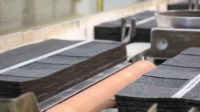
The existing EPDM membrane was cut into 10-foot-by-10-foot squares and placed on pallets for removal. A crane removed the pallets from the roof onto the ground, where they were stored until a flatbed trailer arrived to deliver them to the recycling center.
Energy efficiency, re-use, and recyclability are buzzwords in the roofing industry, and while such terms have a tendency to lose their meaning over time, some in the business take them very seriously. With landfill space at a premium, recycling has become much more than a fad. Instead, it is increasingly providing a cost-effective, environmentally friendly, and easy alternative to skyrocketing waste disposal rates. When a retail food supermarket in East Greenbush, N.Y. decided to re-roof, they embraced the concept of recycling the old roofing material.
Many building owners might be surprised that recycling is an option; however it is quickly becoming a standard in cities throughout the United States due to the environmental and cost advantages the process poses. “This owner is very forward thinking when it comes to environmental issues,” said Carlisle Technical Sales Representative Steve Benjamin. “When it was suggested by Carlisle to recycle the existing roof, they jumped at the chance.”
The original ballasted EPDM system was to be replaced with a new single-ply membrane roofing system from Carlisle, the building owner’s standard manufacturer for re-roofing and new construction projects. Instead of going with another ballasted system, they opted for a mechanically fastened membrane.
“The new roofing system was well-suited for this particular application - utilizing a mechanically attached design with the existing metal deck,” said Bob Minder, Vice President of Sales for roofing contractor S.D. Carruthers.

When the original ballasted EPDM system on a retail food supermarket in East Greenbush, N.Y., shown here, was replaced with a new single-ply membrane roofing system from Carlisle, the old membrane was recycled. Photo courtesy of Carlisle-SynTec.
Investing in Roofing Solutions for Over 45 Years
S.D. Carruthers removed the stone ballast by power vacuuming it off of the roof, exposing the existing EPDM membrane below, which was then cut into 10-foot-by-10-foot squares for removal. Each square was folded and placed on a pallet at the edge of the roof. A crane removed the pallets from the roof onto the ground, where they were stored until a flatbed trailer arrived to deliver them to the recycling center.Carlisle’s Roof Recycling Program has helped divert millions of pounds of roofing material from landfills, while keeping costs approximately equal with landfill disposal due to a broad network of recycling centers located throughout the country. Those recycling centers receive the old membrane for use in the creation of new industrial products. Not only does Carlisle’s Roof Recycling Program help building owners to reduce their carbon footprint, it also helps buildings earn credits toward LEED certification. Carlisle works directly with Nationwide Foam Inc., a material recycler, which then coordinates all aspects of the recycling process for the building owner, including container delivery, removal and transportation.
“The existing EPDM membrane was loose-laid under stone ballast, and the building characteristics allowed the roofer to lower the old membrane to the ground with little extra work,” said Benjamin. “These factors combined to make the process simple for Carruthers.”
A full 24 pallets were loaded onto a flatbed for transportation. The 68,000 square feet of material was shipped to a recycling center - an inexpensive and easy process for the building owner. “The recycling process did not significantly influence the cost of this project,” said Minder. “Only an incremental amount of added labor was involved for palletizing the membrane and loading it onto a flatbed, as compared to cutting it up and throwing it into a roll-off.”
With Carlisle taking care of the details, the workers were free to focus their efforts on the new roof installation. Crews mechanically fastened half-inch Carlisle HP Recovery Board to the existing insulation, which was salvaged from beneath the ballasted EPDM membrane that was previously removed. The joints between each Carlisle HP Recovery Board were staggered from the existing insulation joints to reduce the likelihood of thermal bridging. In one location, Carruthers also installed tapered polyiso crickets to alleviate the possibility of ponding water.
The new membrane was mechanically attached to the roof, and all penetrations, drains and parapet walls were flashed with field-fabricated flashings, while Carlisle prefabricated pipe-boots were used on the pipes. With the process complete, the grocery store got not only a brand-new roof covered under a 15-year total system warranty, but the opportunity to help the environment by giving the old roof back for recycling.
For more information, visitwww.carlisle-syntec.com.




Report Abusive Comment